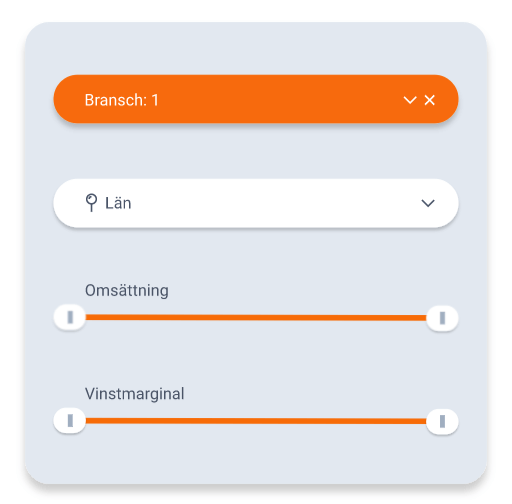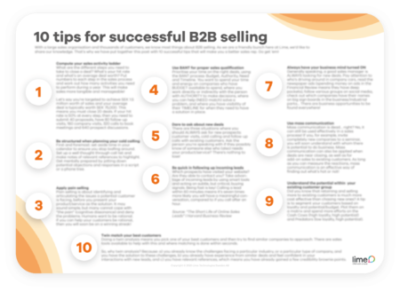The optimal sales technique for cold calling

How can I use cold calling successfully? This is a common question for anyone working in sales. Even if you work with inbound marketing, social selling or other data-driven methods, the following still applies: The most effective strategy for creating a contact and building trust is to meet or talk.
It doesn’t take much to pick up the phone and dial the right number. But the very idea of ‘cold calling’ might seem like a huge challenge. You might immediately start wondering what the best time to call would be, and whether the customer is actually interested or not.
You read your colleague’s note in your CRM: “Eva’s written here that they definitely don’t want to hear from us ever again. Maybe it’s better to just leave them alone?” Even though the note is a year old, you suddenly have doubts. Maybe the customer won’t even pick up?
And yes, that’s definitely possible. Most cold calls in B2B don’t lead to a meeting or a deal. But it might not be because of you or your company – but that the customer simply isn’t expecting you to get in touch. Refine your cold calling strategy with the right sales techniques to get your message across quickly.
The right sales technique is the key to successful cold calls
You’ve received a list of potential new customers to phone. Although cold calls are something lots of salespeople were hoping would fall by the wayside with the transition from modem to Wifi, it’s something all salespeople need to master.
It’s time to roll up your sleeves and sharpen your sales technique. If the term ‘cold calling’ sends chills down your spine, try another phrase: ‘Chill conversations’ sounds better, and you can always count on even the coolest customer to thaw over time.
What is cold calling?
Cold calling means phoning someone you haven’t had contact with previously. Often, the person doesn’t have a strong link to your business or the services you sell. Quite simply, they’re not ready for your call.
Despite this, you need to find a way to quickly reach them and build their trust. We can help you sharpen your sales technique with these five simple ingredients.

Build a strong sales pitch for your cold call
To build a strong sales pitch, you need to understand how your product or service works. When you know what issues your product solves and why the customer should choose you as their supplier, it will be ten times easier to convey that in a clear way – even from the first conversation.
A good understanding of the product is one of the things that defines a great seller. Your sales pitch should be unique, and build on your strengths as a seller. Capture your dream customer in that first conversation, with our five top rules for sales pitches:
- Start the conversation with something that catches their interest. This could be a question, a statement or something unexpected that makes the customer really pay attention to what you have to say.
- Draw the customer into your pitch by looking at things from their perspective. Mention something you have in common or a current event you know the customer can relate to.
- Sell your offer with a story. We often don’t remember facts or figures, but we remember stories. With a clear narrative – mention a similar situation or tell a story, you’ll quickly create a relationship with the customer – and you’ll make a stronger impression.
- Feel free to comment on your competitor, and make it clear how you’re different from them.
- Lead the conversation by asking the right questions at the right time. Be prepared for any objections that often come up. Don’t take over with a monologue, help the customer move through the call with you by adding variety with open and leading questions.
Even cold calling requires knowing what challenges the customer might be facing
Not all customers have the same challenges, but there are always some common denominators. Understanding your customers’ daily lives, challenges and limitations means you can link these factors to a solution and what you have to offer.
You can work with a target audience, or personas, but when it comes down to it, each conversation is unique. You need to have the basic company information to hand, as well as the customer’s name and title. The more familiar you are with the customer’s situation, the easier it is to build trust.

Researching customers – with finesse
An easy way in is to find out how long the person has worked at the company or in their current position. For example, you can check LinkedIn to see where the person has worked before. Maybe you both had the same workplace at some point? Did the customer’s previous employer use the solution you offer?
Nobody likes a nosy person. Even if you know where the person has worked, don’t mention it outright. You can, however, mention a customer who is satisfied, in passing.
“For example, Company X uses this to keep its records up to date. They’ve had it for two years and are really pleased with it. I imagine that your role has similar challenges. Do you know company X?”
“Yes, I actually worked with them for five years before I started here,” answers the customer.
You have immediately established credibility, with information about the customer – you only need to deliver with finesse to succeed.
Write a sales script for cold calls
A sales script should never be just read out word for word. It’s not a list of instructions, but just a guideline for the most important parts to include in your conversation. Your sales script should have five parts:
- Starting the conversation: you need to be clear and concise. Decide how you want to be perceived: easygoing, authoritarian or empathetic?
- Introduce yourself: explain who you are and what you want.
- Carry out a needs analysis: Listen to the customer carefully, to better understand their needs and challenges. From here, the conversation can develop in many ways. Prepare two or three different scenarios as a starting point.
- Present your solution: Based on the customer’s needs, it’s time to show how your solution is the next step they should take. Start from the customer’s point of view – avoid talking too much about the product details or your own company. Show that you want to find the best solution for the customer.
- Ending the call: If the goal of the conversation is to book a meeting, then you need to be clear about that. Give the customer two options with concrete times for a meeting, rather than asking: “When can we meet?” The customer shouldn’t have to think too much – just give them suggestions and let them decide what is best. This way you reduce the risk of the customer being fully booked. It should be you who leads the conversation, not the customer.
“Cheese!” – prepare mentally for every sales call
Did you know that your smile can be heard when you talk? Everyone likes to chat with positive people, and it’s especially important when cold calling.
With the right mental attitude, you create the perfect conditions for success in every call. If you call a customer and are only thinking about how to cover all the points in your sales script, that will be noticeable. You stop being present, and it’s impossible for you to pick up the signals that the customer is sending you during the call.
How do you mentally prepare to get the energy into and out of every sales call?
- Start to smile as soon as you dial. Smiling also releases endorphins, which makes you calmer when the customer picks up.
- Collect your thoughts and focus on the customer. Don’t let your own nervousness lead the conversation. It doesn’t benefit you or the customer. With a pre-prepared sales pitch and script, you can relax and listen to the customer calmly.
- Be aware of your voice and tone. When we’re nervous, we tend to speak faster and with a louder voice. Take five deep breaths while you wait for the feelings to pass. With a lower pitch and a relaxed voice, you’ll be perceived as more credible.
- Your goal is to create a win-win situation. Enter the conversation on the basis that your offer is interesting to the customer. Not everyone will listen to you – for many reasons. But a ‘no’ is never personal, and a positive attitude is crucial for you to be able to keep calling all the customers on your list.
- Use your body language – even though the customer can’t see you. First, try sitting down, slouching forward over your desk. Can you feel energy flowing through you? Probably not. Then try standing up and gesturing during the conversation, as if the person was standing right in front of you. Your body language, and how engaged in the conversation you are, will be noticeable in your speech – just as your smile is reflected in your voice.
By preparing yourself mentally you increase your presence, and become the person who leads the conversation. Remember – the customer might not be expecting your call, but you know exactly how you want the conversation to go. Use that to your advantage.
Download: 10 sales tips for B2B

Don’t miss our guide with concrete sales tips on how to succeed in every sales call.
What are you waiting for?
There’s no time to waste! Let’s find the solution that will help you get more customers and turn existing ones into loyal ambassadors today.